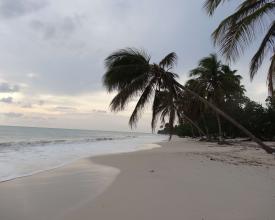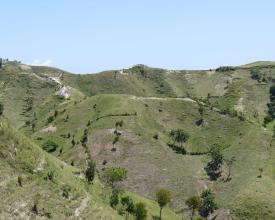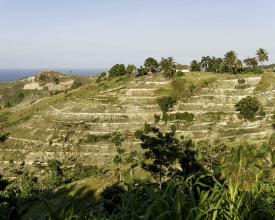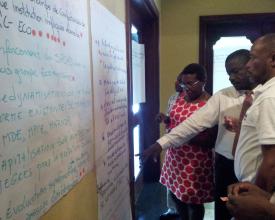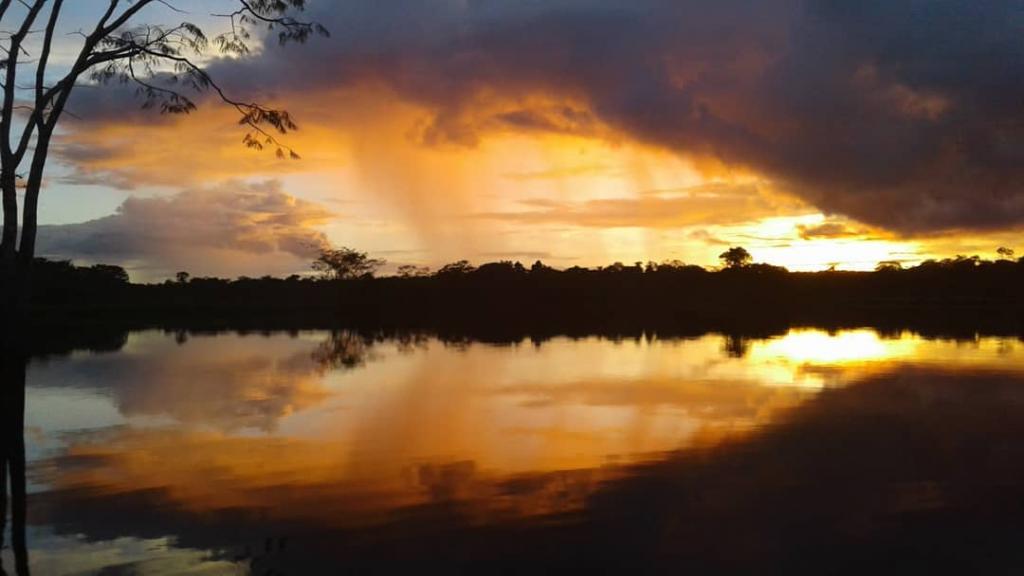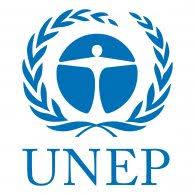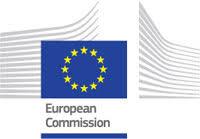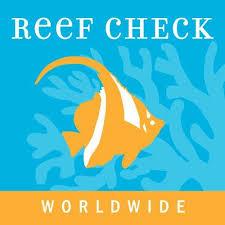
Applying ecosystem-based disaster risk reduction through a ridge to reef approach
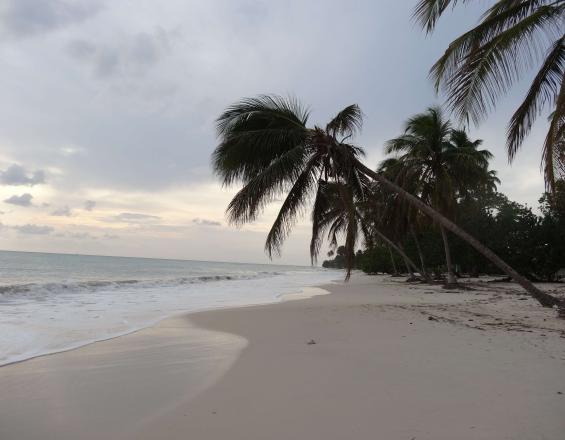
This pilot project aimed to demonstrate how ecosystem-based measures could mitigate climate hazards and reduce vulnerabilities in Haiti through a ridge to reef approach. It implemented revegetation and sustainable vetiver farming to reduce risk of erosion and inland flooding, revegetation of coastal forest to buffer against storm surges and coastal flooding and created sustainable and resilient fisheries to increase local resilience; it also improved capacity and supported national advocacy.
The project undertook an Eco-DRR approach by targeting hazards (flooding, storm surges and erosion) and vulnerability (due to unsustatinable management) and increasing disaster prepardeness (e.g. early warning) to reduce disaster risk. However, these hazards are climatic hazards and impacts that are increasing due to climate change and increasing peoples vulnerability to climate change. Therefore, the ecosystem-based measures in this project undertaken are also EbA.
Contexto
Défis à relever
Frequent hurricanes and storms assail Haiti and because it is a very poor country this can have a large impact on its economy. Heavy rainfall from the storms create storm surges, coastal flooding and inland flooding in Port Salut. In the uplands, landslides and erosion occur from rainfall and due to environmental degradation from unsustainable practices. Unsustainable fishing is also a problem.
Ubicación
Procesar
Summary of the process
Baseline assessments (building block 1) were the basis from which activities could be undertaken in a Ridge to Reef approach – hill/upland-downstream/shoreline-sea (building block 2). Capacity building for improved coastal management (building block 3) and advocacy for EbA/Eco-DRR in marine protected areas (building block 4) ensure the sustainability of the project.
Building Blocks
Baseline Assessments
Field surveys were undertaken to map the extent of marine and terrestrial ecosystems, develop an ecological baseline and identify areas and measures for ecosystem-based interventions. Field surveys also identified locations of infrastructure exposed to river flooding. Remote sensing and GIS modelling provided complementary data and were used to assess exposure of the population to storm surges and flooding under current and future conditions. The InVest coastal vulnerability model was used to assess coastal exposure under different ecosystem management scenarios.
A planning and feasibility study for coastal restoration was also undertaken.
Enabling factors
The Audubon Society of Haiti and Reef Check helped undertake field surveys and developed the planning and feasibility study.
The relatively low data requirements of the InVest model and the fact that it takes into account both the geophysical and ecological characteristics of the area in measuring coastal exposure make the InVest model highly suitable for EbA/Eco-DRR planning and for data-poor countries.
Lesson learned
The results of the InVest model were in line with observed patterns of exposure. For instance, areas that are identified by the model as highly exposed to coastal hazards at present were in fact some of the areas that were most impacted by Hurricane Sandy in 2012. The results also point to the importance of protecting and rehabilitating ecosystems that mitigate hazards, so that they can in turn protect the community. However, depending on circumstances ecosystems may not provide the best nor full protection. The results cannot be used therefore to prescribe a best solution but only highlight the trade-offs and potential outcomes of different ecosystem management decisions especially as the model does not provide a comprehensive analysis.
Resources
Ridge to Reef Approach
The ridge to reef approach aims to provide a holistic intervention for protecting the coastal area by targeting environmental degradation in the uplands ("ridge") that impact coastal ecosystems through sedimentation, by restoring the shoreline and protecting marine ecosystems ("reef"), thereby mitigating storm surges, coastal and inland flooding and reduce people’s exposure and vulnerability to these hazards. At the same time, aiming to provide direct livelihood benefits to targeted households and stakeholders in the project.
- Uplands: Reduce erosion in upland areas through
- improved soil management of 6.5 ha of sustainable vetiver production, which also increases economic benefits.
- establishment of tree nurseries with a capacity of 137,000 seedlings of coastal, forestry and fruit trees;
- 25,380 trees planted on 137 ha near riverbanks to reduce upland erosion and sedimentation.
- Shore: Create natural coastal buffers through re-vegetation of 3.82 ha of coastal areas (0.66 ha in rivermouths and 3.2 ha in shorelines)
Sea: Create resilient and sustainable fishing through strenghening the fishers association in Port Salut and responding to some of their needs to reduce nearshore fishing.
Enabling factors
The project built on UNEP’s presence and ongoing activities in the South Department of Haiti, such as the Côte Sud Initiative.
The ecosystem-based interventions in Port Salut were designed to deliver multiple livelihood benefits in addition to disaster risk reduction/climate change adaptation. For instance, more sustainable vetiver cultivation can produce higher quality produce which increases income.
Lesson learned
The re-vegetation and re-forestation along rivers and coastal areas was monitored. In the uplands, much of this occurred on private land and landowners were trained and given technical assistance. The monitoring indicated a 75% seedling survival in those areas. In the communal coastal areas, however, survival rate was 57%. A number of field visits took place to identify the reasons for this and necessary steps to establish adaptive management and improved practices in the future. These steps included awareness raising to catalyse more protection of the seedlings by the community and improving planting techniques.
The project invested in strengthening community-based organizations (vetiver farmers and fishers) as a key mechanism for implementing project activities. This was effective in Haiti because it addresses a key vulnerability of vetiver farmers and fishers. However, these community-based organizations still require sustained capacity development support.
Capacity building for improved coastal management
Capacity building activities included:
- Awareness raising
- Trainings and workshops
- Hands-on learning activities at the field sites
- Supporting improved municipal coordination
- field visits and study tours with government and other partners
The project focused on re-enforcing the capacities of actors on the ground (local community-based organizations as well as capacities of the Municipal Government), to implement ecosystem-based interventions and therefore much was "learning-by-doing".
The project also aimed to strengthen coastal governance at the municipal level and capacity for sustainable coastal zone management through the creation of a Municipal Coordination Roundtable, trainings and support.
At the national level capacity building efforts were directed at raising national awareness of the importance of the ridge-to-reef approach to disaster risk reduction and climate change adaptation and need for sustainable coastal zone management.
Enabling factors
Working with community-based organizations cements on the ground training in these practical field interventions and their maintenance.
Furthermore, having field activities serve as an entry point to promote ecosystem-based activities within the framework coastal governance at the national level and raise national awareness of coastal and marine issues.
Lesson learned
The limited technical capacities and resources at the municipal level was a challenge. Introducing participatory dialogue through the Municipal Coordination Roundtable, was helpful, especially for civil society organizations, which gained a more direct access and involvement in municipal planning and decision-making. It also enabled the Municipal Government to take on a more visible role in coastal zone management. However, absences and turnovers in Municipal Government also made it difficult to anchor training efforts and build long-lasting capacity within local government institutions. One lesson learned from the project was to work closely with the more permanent, technical Municipal Government staff and strengthen their capacities and ownership of the project. In addition, UNEP built partnerships and agreements with different Government entities to manage local political instability and lack of continuity.
Advocacy for EbA/Eco-DRR in marine protected areas
Designing Marine protected areas help protect ecosystems so that they can provide their multiple services such as coastal protection and food sources.
The project supported the case for the declaration of Port Salut as one of the MPAs, by making baseline data available on the diversity and status of coastal and marine ecosystems in the area and emphasizing the multiple benefits of protecting these ecosystems, in particular for disaster risk reduction and climate change adaptation. The protected area of managed resources of Port Salut/Aquin now covers 87,422 hectares of the coastal zone of Port Salut Municipality.
Enabling factors
Having field activities serve as an entry point to promote ecosystem-based activities within the framework of marine protected areas and coastal governance at the national level and raise national awareness of coastal and marine issues.
Lesson learned
Before 2013, Haiti was the only Caribbean country without Marine Protected Areas (MPA). UNEP leveraged on initial governmental discussions that had taken place while the project was being conceptualised and supported the Government of Haiti to finalize the designation of marine protected areas in Haiti, and provided technical assistance to the Government to draft the MPA declaration. In 2013 the Government of Haiti declared the country’s first nine marine protected areas including the coastal zone of Port Salut - with the objective to “maintain biodiversity, while responding to the needs of the communities that depend on these natural systems”.
Impacts
Soil erosion and river sedimentation are reduced through upland sustainable vetiver farming and revegetation around the banks of Carpentier River, thus also mitigating inland flooding and reducing negative impacts on coastal and marine ecosystems from sedimentation run-off.
Coastal zones are more protected by the plantation of coastal forests and mangroves.
Fishing pressure and degradation of coastal and marine ecosystems are reduced through encouraging offshore fishing, thus protecting natural ecosystems so that they can provide their services, such as coastal protection.
The project also increased resilience through strengthening sustainable fishing and farming, raising national awareness on ecosystem-based measures and informing national policy and planning, including the creation of marine protected areas.
Beneficiaries
90 fishermen, 25 farmers, and 350 households in Port Salut, Haiti.
Sustainable Development Goals
Story
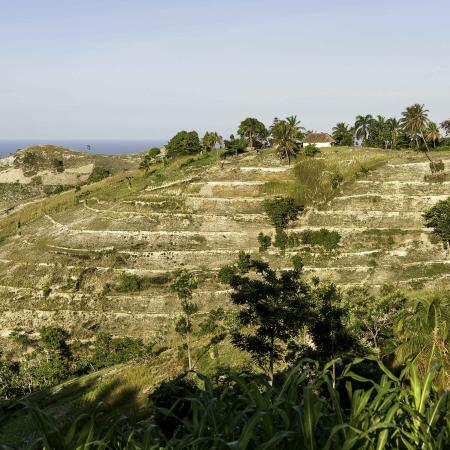
Fishermen in Port Salut face storms on a regular basis which threatens their safety and income. Coastal flooding and sedimentation from upstream erosion as well as nearshore also place pressure on the marine ecosystem which in turn impact fishing. Coastal flooding also severely impacts houses and hotels that are built along the shoreline placing many people at risk.
Upstream, landscape degradation and unstainable farming, and storms impact not only the environment but also the farmers who are dependent on the environment for subsidence and income.
UNEP, funded by the European Commission partnered with the Haiti Government, several NGOs and both the fishermen and vetiver farmers' associations to undertake pilot ecosystem-based measures through a ridge to reef approach to demonstrate the potential to reduce inland and coastal flooding and increase resilience of the local population.
A ridge to reef approach provides an integrated way to protect coastal ecosystems and their services and to mitigate a downstream sequence of events that impact lives and livelihoods from source to sea.
The field interventions undertaken:
- Re-vegetation and sustainable vetiver farming to reduce the risk of upland erosion and inland flooding; In addition to planting trees along river beds, the project supported cooperative farmers to practice more sustainable vetiver cultivation practices that are aimed to improve vetiver quality and yields, in addition to reducing soil erosion.
- Coastal re-vegetation as natural buffers against coastal hazards, such as storm surges and coastal flooding and thus protect the local infrastructre and people's lives;
- Sustainable and resilient fisheries to increase local resilience to disasters. Through the project, fishermen learnt life saving skills for at sea and repaired boats, which allowed them to fish offshore thus protecting the coastal environment. An ealy warning system was also set in place.
The project also support the process of designating Port Salut as one of the first marine protected areas.
